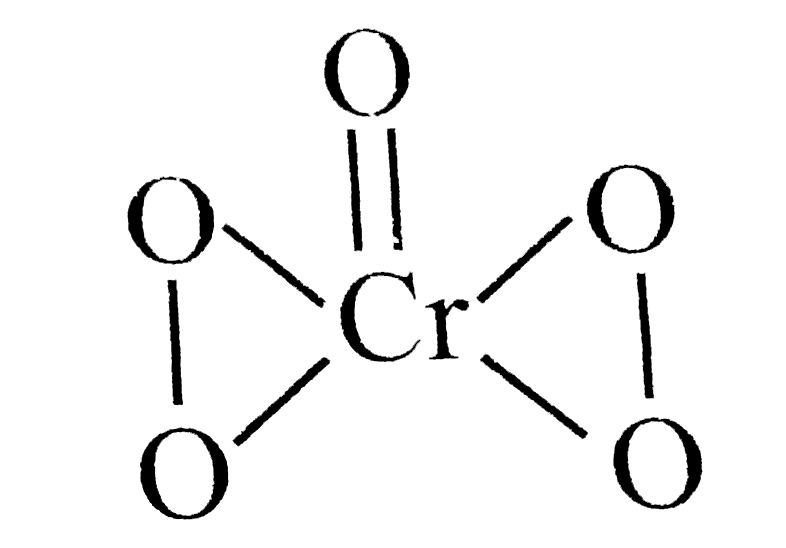Calculate the oxidation number of Chromium in CrO5 . Suggest structure of this compound. Count for the fallacy.
To calculate the oxidation number of chromium in CrO₅ and suggest its structure, we can follow these steps:
Step 1: Identify the oxidation states
In the compound CrO₅, we need to determine the oxidation state of chromium (Cr). We know that the oxidation state of oxygen (O) is generally -2. However, in CrO₅, we will need to consider the possibility of peroxide bonds.
Step 2: Set up the equation
Let the oxidation number of chromium be X. Since CrO₅ is a neutral compound, the sum of the oxidation numbers must equal zero. The equation can be set up as follows:
X+(−2)×5=0
Step 3: Solve for X
Now, substituting the values into the equation:
X−10=0
Solving for X:
X=+10
Step 4: Analyze the fallacy
The calculated oxidation number of chromium is +10, which is not possible because the maximum oxidation state of chromium is +6 (as seen from its electronic configuration: Argon 3d⁵ 4s¹). This indicates a fallacy in our initial assumption about the structure of CrO₅.
Step 5: Consider the structure of CrO₅
To resolve this, we need to consider that CrO₅ contains peroxide bonds. In CrO₅, there are two oxygen atoms that are part of peroxide bonds (O-O), which have an oxidation state of -1.
Step 6: Set up the new equation
Now, we can revise our equation to account for the peroxide bonds. The structure of CrO₅ can be represented as:
- One oxygen double-bonded to chromium (with an oxidation state of -2).
- Four oxygen atoms, two of which are in peroxide form (with an oxidation state of -1 each).
Thus, the equation becomes:
X+(−1)×4+(−2)=0
Step 7: Solve the revised equation
Now substituting the values:
X−4−2=0
Solving for X:
X−6=0⟹X=+6
Conclusion
The oxidation number of chromium in CrO₅ is +6.
Suggested Structure
The structure of CrO₅ can be visualized as:
- One Cr=O double bond
- Two O-O peroxide bonds
Count for Fallacy
The initial assumption that all oxygen atoms in CrO₅ had an oxidation state of -2 led to the incorrect conclusion of +10 for the oxidation state of chromium. Recognizing the presence of peroxide bonds corrected this to the valid +6 oxidation state.
---
In the compound CrO₅, we need to determine the oxidation state of chromium (Cr). We know that the oxidation state of oxygen (O) is generally -2. However, in CrO₅, we will need to consider the possibility of peroxide bonds.
Let the oxidation number of chromium be X. Since CrO₅ is a neutral compound, the sum of the oxidation numbers must equal zero. The equation can be set up as follows:
Now, substituting the values into the equation:
The calculated oxidation number of chromium is +10, which is not possible because the maximum oxidation state of chromium is +6 (as seen from its electronic configuration: Argon 3d⁵ 4s¹). This indicates a fallacy in our initial assumption about the structure of CrO₅.
To resolve this, we need to consider that CrO₅ contains peroxide bonds. In CrO₅, there are two oxygen atoms that are part of peroxide bonds (O-O), which have an oxidation state of -1.
Now, we can revise our equation to account for the peroxide bonds. The structure of CrO₅ can be represented as:
- Four oxygen atoms, two of which are in peroxide form (with an oxidation state of -1 each).
Now substituting the values:
The oxidation number of chromium in CrO₅ is +6.
The structure of CrO₅ can be visualized as:
- One Cr=O double bond
- Two O-O peroxide bonds
The initial assumption that all oxygen atoms in CrO₅ had an oxidation state of -2 led to the incorrect conclusion of +10 for the oxidation state of chromium. Recognizing the presence of peroxide bonds corrected this to the valid +6 oxidation state.
Topper's Solved these Questions
- REDOX REACTIONS (OXIDATION AND REDUCTION)BOOK - ICSECHAPTER - REDOX REACTIONS (OXIDATION AND REDUCTION)EXERCISE - NUMERICAL PROBLEMS
4 Videos
- ORGANIC CHEMISTRY : SOME BASIC PRINCIPLES AND TECHNIQUES BOOK - ICSECHAPTER - ORGANIC CHEMISTRY : SOME BASIC PRINCIPLES AND TECHNIQUES EXERCISE - NCERT TEXT-BOOK EXERCISES (WITH HINTS AND SOLUTIONS )
72 Videos
- SAMPLE QUESTION PAPERBOOK - ICSECHAPTER - SAMPLE QUESTION PAPEREXERCISE - Question
69 Videos
Similar Questions
Calculate the oxidation number of Sulphur in H2SO5. Suggest structure of this compounds. Count for the fallacy.
View SolutionCalculate the oxidation number of nitrogen in NO−3. Suggest structure of this compound. Count for the fallacy.
View SolutionCalculate the oxidation numbers of Cr in K3CrO8:
View SolutionOxidation number of Cr in CrO5 is
View SolutionCalculate the oxidation number of Mn in KMnO4 molecule.
View SolutionThe oxidation number of Cr in CrO(5) which has the following structure is

View SolutionThe oxidation state of Cr in CrO5 is
View SolutionOxidation state of oxygen in CrO5 is
View SolutionOxidation number of Xe in XeF−5 is :
View SolutionCalculate the oxidation number of sulphur, chromium, and nitrogen in H2SO5,Cr2O2−7 and NOΘ3. Suggest the structure of these compounds. Count for the fallacy.
View Solution
